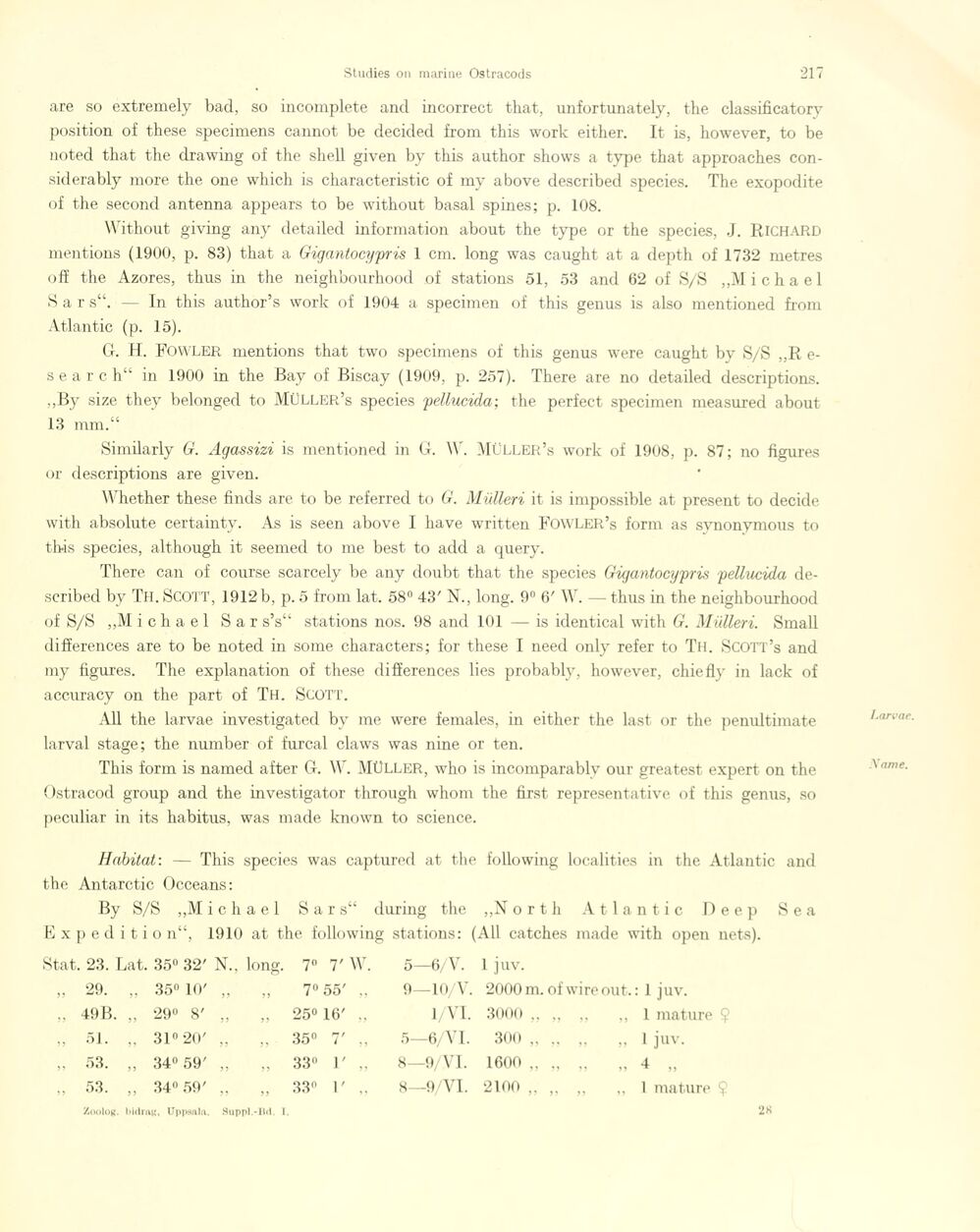
Full resolution (JPEG) - On this page / på denna sida - Sidor ...

<< prev. page << föreg. sida << >> nästa sida >> next page >>
Below is the raw OCR text
from the above scanned image.
Do you see an error? Proofread the page now!
Här nedan syns maskintolkade texten från faksimilbilden ovan.
Ser du något fel? Korrekturläs sidan nu!
This page has never been proofread. / Denna sida har aldrig korrekturlästs.
are so extremely bad, so incomplete and incorrect that, unfortunately, the classificatory
position of these specimens cannot be decided from this work either. It is, however, to be
noted that the drawing of the shell given by this author shows a type that approaches
con-siderably more the one which is characteristic of my a bove described species. The exopodite
of the second antenna appears to be without basal spin es; p. 108.
Without giving any detailed information about the type or the species, J. Richard
mentions (1900, p. 83) that a Gigantocypris 1 cm. long was caught at a depth of 1732 metres
off the Azores, thus in the neighbourhood of stations 51, 53 and 62 of S/S „Michael
Sar s“. — In this author’s work of 1904 a specimen of this genus is also mentioned from
Atlantic (p. 15).
G. H. Fowler mentions that two specimens of this genus were caught by S/S „R
e-search“ in 1900 in the Bay of Biscay (1909, p. 257). There are no detailed descriptions.
„By size they belonged to MUller’s species pellucida; the perfect specimen measured about
13 mm.“
Similarly G. Agassizi is mentioned in G. \V. Müller’s work of 1908, p. 87; no figures
or descriptions are given.
Whether these finds are to be referred to G. Mülleri it is impossible at present to decide
with absolute certainty. As is seen above I have written Fowler’s form as synonymous to
tbis species, although it seemed to me best to add a query.
There can of course scarcely be any doubt that the species Gigantocypris pellucida
described by Th. SCOTT, 1912b, p. 5 from lat. 58° 43’ N., long. 9n 6’ W. — thus in the neighbourhood
of S/S „M ichael Sar s’s“ stations nos. 98 and 101 — is identical with G. Mülleri. Small
differences are to be noted in so me characters; for these I need only refer to Th. SCOTT ’s and
my figures. The explanation of these differences lies probably, however, chiefly in lack of
accuracy on the part of Th. Scott.
AU the larvae investigated by me were females, in either the last or the penultimate
larval stage; the number of furcal claws was nine or ten.
This form is named after G. M’. MÜLLER, who is incomparablv our greatest expert on the
Ostracod group and the investigator through whom the first representative of this genus, so
peculiar in its habitus, was made known to science.
Habitat: — This species was captured at the foUowing localities in the Atlantic and
the Antarctic Occeans:
By S/S „M ichael Sars“ during the „N o r t h Atlantic Deep S e a
Expedition“, 1910 at the following stations: (All catches made with open nets).
Stat. 23. Lat. 35° 32’ N., long. 7° 7’ W. 5—6/V. 1 juv.
,, 29. ,, 35° 10’ „ „ 7° 55’ „ 9—10/V. 2000 m. of wire out.: 1 juv.
„ 49 B. „ 29° 8’ „ „ 25° 16’ .. 1/VI. 3000., „ „ „ 1 mature
„ 51. „ 31° 20’ „ „ 35° 7’ „ 5—6/V1. 300 „ .. „ „ 1 juv.
„ 53. „ 34° 59’ „ „ 33° 1’ „ 8—9/V1. 1600., „ „ 4 „
„ 53. „ 34° 59’ „ „ 33° 1’ .. 8—9/VI. 2100,, „ „ „ l mature $
Zoolog, bidrog, Uppsala. Suppl.-Bd. I. 2b
Larvae.
Xante.
<< prev. page << föreg. sida << >> nästa sida >> next page >>